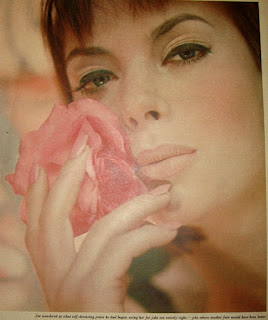One more This Week story and then I'll move on to other things.
In 1964 John D MacDonald published seven stories in the Sunday supplement, the most of any single year. Throughout the 1950's the author wrote at least one submission-- usually more -- each year in This Week up until 1958, when "Man in a Trap" appeared. That effort -- at 4,750 words,his longest This Week story of all -- was the last that would be published for five years. In October of 1963, "End of the Tiger" appeared, then, the following year, he made up for lost time. I'm not sure if there was an editorial change behind this gap, or if JDM was simply busy doing other things (and wasn't he always!), but beginning with "Tiger" his This Week writing became deeper and more nuanced.
"The Loveliest Girl in the World" appeared in the March 15, 1964 issue and ran 3,000 words, his second-longest TW tale. The blurb that ran along the top of the story's page describes the plot succinctly: "A young girl and an older man who fell deeply, almost irrevocably, in love."
The story begins beautifully: "She was a chrysanthemum girl, slender by all sane standards, yet not gaunted to the thinness of a high-fashion model." She is Jean Anne Burch, from Canton, Ohio, and she is an ad-agency model in New York, now going by the stage name of Lya Shawnessy. Jean Anne has been doing a lot of work for successful photographer Joe Kardell, and not always because she was the best choice for the job. "[He] had started using her in the winter, using her for things exactly right for her, and he wondered at what subtle and self-deceiving point he had begun using her for jobs not exactly right, jobs where another face would have been better, jobs where he could overcome that small discrepancy through his total mastery of his tools." Joe is middle-aged, married and with two teen-aged children, but he has fallen in love with Jean Anne, and she with him. This is obvious to Joe's two studio assistants, although what they don't know is that the "affair" has never been consummated. Joe and Jean Anne have never even met outside of his studio. It's simply a realization between the two of them that something has happened.
Then something does happen. Joe becomes overcome with emotion during a shoot, dismisses everyone and then waits for Jean Anne outside in the hall. They get into his car and drive, ending up at a motel, but after three abrupt and awkward kisses in the car, they decide to go to the motel's restaurant and talk.
MacDonald has been referred to as a "moralist," a characterization he often used himself. It is a trait that becomes quickly obvious to the readers of his early works, and the 1950's featured a series of what writer Garry Emmons refers to as "morality books." These include such titles as Cancel All Our Vows, Contrary Pleasure and, perhaps the best example, Clemmie. In each case, the heroes, like characters in a classic tragedy, carry the seeds of their own demise, and are either undone by their transgressions or survive, battered but stronger and more self-aware. Joe Kardell is a member of this club, and in this story we are allowed to observe the thought process that goes on while he rationalizes, briefly succumbs, then makes a fateful decision. In "The Loveliest Girl in the World" we are also blessed with a female character equally as articulate, aware and as strong as Joe. And, as much in love as he is, but she allows Joe to make the ultimate decision about their relationship.



No comments:
Post a Comment